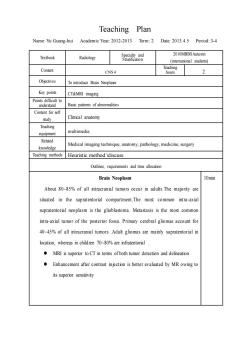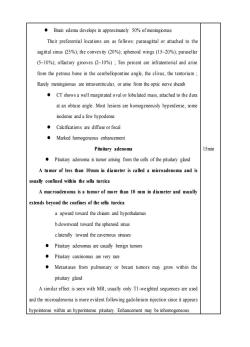山东第一医科大学(泰山医学院):《医学影像学》课程教学资源(授课教案)8.CNS4

Teaching Plan Name:Yu Guang-hui Academic Year:2012-2013 Term:2 Date:2013.4.5 Period:3-4 2010MBBSAutumn Textbook Radiology a (students) Content CNS4 Teaching 2 Objectives To introduce Brain Neoplasm Key points CT&MRI imaging Points difficult to Basic pattems of abnormalities Content for self study Clinical anatomy Teaching equipment multimedia Related knowledge Medical imaging technique,anatomy,pathology,medicine,surgery Teaching methods Heuristic method discuss Outlines,requirements and time allocation Brain Neoplasm 10min About 80~85%of all intracranial tumors occur in adults.The majority are situated in the supratentorial compartment.The most common intra-axia supratentorial neoplasm is the glioblastoma.Metastasis is the most common intra-axial tumor of the posterior fossa.Primary cerebral gliomas account for 40-45%of all intracranial tumors Adult gliomas are mainly supratentorial in location,whereas in children 70~80%are infratentorial. MRI is superior toCT in tems of both tumor detection and delineation Enhancement after contrast injection is better evaluated by MR owing to its superior sensitivity
Teaching Plan Name: Yu Guang-hui Academic Year: 2012-2013 Term: 2 Date: 2013.4.5 Period: 3-4 Textbook Radiology Specialty and Stratification 2010MBBSAutumn (international students) Content CNS 4 Teaching hours 2 Objectives To introduce Brain Neoplasm Key points CT&MRI imaging Points difficult to understand Basic patterns of abnormalities Content for self study Clinical anatomy Teaching equipment multimedia Related knowledge Medical imaging technique, anatomy, pathology, medicine, surgery Teaching methods Heuristic method \discuss Outlines, requirements and time allocation Brain Neoplasm About 80~85% of all intracranial tumors occur in adults.The majority are situated in the supratentorial compartment.The most common intra -axial supratentorial neoplasm is the glioblastoma. Metastasis is the most common intra-axial tumor of the posterior fossa. Primary cerebral gliomas account for 40~45% of all intracranial tumors .Adult gliomas are mainly supratentorial in location, whereas in children 70~80% are infratentorial . ⚫ MRI is superior to CT in terms of both tumor detection and delineation ⚫ Enhancement after contrast injection is better evaluated by MR owing to its superior sensitivity 10min

Astrocytoma According to haemorrhage,calcification,edema around tumor,degree of 5min enhancement,astrocytomas are divided into grade I-IV Grade I-II CT without and with intravenous injection of contrast medium.10min Nonenhancing.hypodense space-occupying lesion infiltrates part of the temporal lobe and insula on the right side.Two amrows indicate the compressed and displaced middle cerebral artery branches within the insular portion of the sylvian cistem Marked hyperintensity of the tumor due to the high water content of the neoplastic cells.coronal TIWI The tumor is markedly hypointense. Arrowheads point on the right side at the elevated sylvian fissure by the enlarged temporal lbe. Grade III-IV 10min Infiltrating astrocytomas with ill-defined margin Meningioma 20min Meningioma arise from specialized meningothelial cells mainly in arachnoid granulations.These tumors mostly affect adults with a strong female predilection 2:1 over males)and are rare in childhood.Gross pathology shows two basic configurations:an oval or lobulated mass with a broad-based attachment to the duraor a flattened,linear lesion extending alng the dura Several factors produce tumor heterogeneity:tumoral vascularity,cystic foci and cakcifications Ninety percent are supratentoria Frequently cause hyperostosis of the inner table and can extensively penetrate the skull,causing marked thickening of the bone and osteoblastic reaction bone erosion is rare
Astrocytoma According to haemorrhage, calcification, edema around tumor, degree of enhancement, astrocytomas are divided into grade I-IV Grade I-II ⚫ CT without and with intravenous injection of contrast medium. Nonenhancing, hypodense space-occupying lesion infiltrates part of the temporal lobe and insula on the right side. Two arrows indicate the compressed and displaced middle cerebral artery branches within the insular portion of the sylvian cistern ⚫ Marked hyperintensity of the tumor due to the high water content of the neoplastic cells. coronal T1WI The tumor is markedly hypointense. Arrowheads point on the right side at the elevated sylvian fissure by the enlarged temporal lobe. Grade III-IV Infiltrating astrocytomas with ill-defined margin Meningioma Meningioma arise from specialized meningothelial cells mainly in arachnoid granulations. These tumors mostly affect adults with a strong female pred ilection (2:1 over males) and are rare in childhood . Gross pathology shows two basic configurations: an oval or lobulated mass with a broad -based attachment to the dura ; or a flattened, linear lesion extending along the dura Several factors produce tumor heterogeneity: tumoral vascularity, cystic foci and calcifications ⚫ Ninety percent are supratentorial ⚫ Frequently cause hyperostosis of the inner table and can extensively penetrate the skull, causing marked thickening of the bone and osteoblastic reaction ;bone erosion is rare 5min 10min 10min 20min

Brain edema develops in approximately 50%of meningiomas Their preferential locations are as follows:parasagittal or attached to the sagittal sinus (25%);the convexity (2%),sphenoid wings(%)parasellar (5-10%);olfactory grooves (210%);Ten percent are infratentorial and arise from the petrous bone in the cerebellopontine angle,the clivus,the tentorium Rarely meningiomas are intraventricular,or arise from the optic nerve sheath CT shows a well marginated oval or lobulated mass,attached to the dura at an obtuse angle.Most lesions are homogeneously hyperdense,some isodense and a few hypodense Calcifications are diffuse or focal Marked homogeneous enhancement Pituitary adenoma 15min Pituitary adenoma is tumor arising from the cells of the pituitary gland A tumor of less than 10mm in diameter is called a microadenoma and is usually confined within the sella turcica A macroadenoma is a tumor of more than 10 mm in diameter and usually extends beyond the confines of the sella turcica a.upward toward the chiasm and hypothalamus b.downward toward the sphenoid sinus c.laterally toward the cavemous sinuses Pituitary adenomas are usually benign tumors Pituitary carcinomas are very rare Metastases from pulmonary or breast tumors may grow within th pituitary gland A similar effect is seen with MR:usually only TI-weighted sequences are used and the microadenoma is more evident following jection since it appears hypointense within an hyperintense pituitary.Enhancement may be inhomogeneous
⚫ Brain edema develops in approximately 50% of meningiomas Their preferential locations are as follows: parasagittal or attached to t he sagittal sinus (25%); the convexity (20%); sphenoid wings (15~20%); parasellar (5~10%); olfactory grooves (2~10%) ; Ten percent are infratentorial and arise from the petrous bone in the cerebellopontine angle, the clivus, the tentorium ; Rarely meningiomas are intraventricular, or arise from the optic nerve sheath ⚫ CT shows a well marginated oval or lobulated mass, attached to the dura at an obtuse angle. Most lesions are homogeneously hyperdense, some isodense and a few hypodense ⚫ Calcifications are diffuse or focal ⚫ Marked homogeneous enhancement Pituitary adenoma ⚫ Pituitary adenoma is tumor arising from the cells of the pituitary gland A tumor of less than 10mm in diameter is called a microadenoma and is usually confined within the sella turcica A macroadenoma is a tumor of more than 10 mm in diameter and usually extends beyond the confines of the sella turcica a. upward toward the chiasm and hypothalamus b.downward toward the sphenoid sinus c.laterally toward the cavernous sinuses ⚫ Pituitary adenomas are usually benign tumors ⚫ Pituitary carcinomas are very rare ⚫ Metastases from pulmonary or breast tumors may grow within the pituitary gland A similar effect is seen with MR; usually only T1 -weighted sequences are used and the microadenoma is more evident following gadolinium injection since it appears hypointense within an hyperintense pituitary. Enhancement may be inhomogeneous. 15min

Not infrequently,the nodule is difficult to detect and dynamic techniques may improve the detection rate Not infrequently the microadenoma may be hyperintense on the baseline TIWI,due to intratumoral bleed Pituitary Macroadenoma 15min A macroadenoma can remain confined within the sella turcica,or it may grow upward,downward,laterally or more commonly in all directions Plain films usually show an expanded sella with erosion and depression of the sellar floor toward the sphenoid sinus CT shows the same bony changes and the mass lesion.usually isointense,with marked enhancement MRI better shows involvement of the surrounding structures The tumor is usually isointense on Tl-weighted images and shows marked enhancement following gadolinium injection.Sometimes haemorrhagic and cystic components are present Acoustic neurinoma 15min A benign tumor deriving from schwann cells of the acoustic nerve It is the most frequent intracranial schwannoma Most commonly the neoplasm originates from the vestibular portion of the eighth cranial nerve It can be exclusively intracanalicular or may extend as a mass in the cerebellopontine angle Plain film radiographs can reveal widening of the internal auditory canal. which,however,is a late manifestation ofthe tumo On CT axial images intracanalicular schwannomas are usually missed Larger tumors both intra-and extracanalicular appear as oval or lobulated masses,they may present as a broad base against the petrous ridge at the
⚫ Not infrequently, the nodule is difficult to detect and dynamic techniques may improve the detection rate ⚫ Not infrequently the microadenoma may be hyperintense on the baseline T1WI, due to intratumoral bleed Pituitary Macroadenoma ⚫ A macroadenoma can remain confined within the sella turcica, or it may grow upward, downward, laterally or more commonly in all directions ⚫ Plain films usually show an expanded sella with erosion and depression of the sellar floor toward the sphenoid sinus ⚫ CT shows the same bony changes and the mass lesion, usually isointense, with marked enhancement ⚫ MRI better shows involvement of the surrounding structures The tumor is usually isointense on T1 -weighted images and shows marked enhancement following gadolinium injection. Sometimes haemorrhagic and cystic components are present Acoustic neurinoma ⚫ A benign tumor deriving from schwann cells of the acoustic nerve ⚫ It is the most frequent intracranial schwannoma ⚫ Most commonly the neoplasm originates from the vestibular portion of the eighth cranial nerve ⚫ It can be exclusively intracanalicular or may extend as a mass in the cerebellopontine angle ⚫ Plain film radiographs can reveal widening of the internal auditory canal. which, however, is a late manifestation of the tumor ⚫ On CT axial images intracanalicular schwannomas are usually missed. Larger tumors both intra - and extracanalicular appear as oval or lobulated masses, they may present as a broad base against the petrous ridge at the 15min 15min

level of the intemal auditory meatus and enlarging the cerebellopontine angle (CPA)cistem.They are iso-to slightly hypodense to brain and show strong but variable enhancement owing to cystic degeneration in larger neoplasms. Calcifications are rare
level of the internal auditory meatus and enlarging the cerebellopontine angle (CPA) cistern . They are iso- to slightly hypodense to brain and show strong but variable enhancement owing to cystic degeneration in larger neoplasms. ⚫ Calcifications are rare
按次数下载不扣除下载券;
注册用户24小时内重复下载只扣除一次;
顺序:VIP每日次数-->可用次数-->下载券;
- 山东第一医科大学(泰山医学院):《医学影像学》课程教学资源(授课教案)7.CNS3.doc
- 山东第一医科大学(泰山医学院):《医学影像学》课程教学资源(授课教案)6.CNS2.doc
- 山东第一医科大学(泰山医学院):《医学影像学》课程教学资源(授课教案)5.CNS1.doc
- 山东第一医科大学(泰山医学院):《医学影像学》课程教学资源(授课教案)4.Foundations of Sonagraphy.doc
- 山东第一医科大学(泰山医学院):《医学影像学》课程教学资源(授课教案)3.Radioloy overview 3.doc
- 山东第一医科大学(泰山医学院):《医学影像学》课程教学资源(授课教案)2.Radiolgy overview 2.doc
- 山东第一医科大学(泰山医学院):《医学影像学》课程教学资源(授课教案)1.Radiology overview 1.doc
- 山东第一医科大学(泰山医学院):《医学影像学》课程教学大纲(英文版)Course syllabus-diagnostic imaging.doc
- 《妇产科学》课程教学资源(PPT课件讲稿)产后出血的诊断与处理.ppt
- 《妇产科学》课程教学资源(PPT课件讲稿)营养孕期(妊娠期营养).ppt
- 《妇产科学》课程教学资源(PPT课件讲稿)孕产妇用药.ppt
- 《妇产科学》课程教学资源(PPT课件讲稿)妊娠合并卵巢肿瘤诊疗进展.ppt
- 《妇产科学》课程教学资源(PPT课件讲稿)新生儿复苏策略新进展.ppt
- 《妇产科学》课程教学资源(PPT课件讲稿)孕前和孕期保健指南(第一版).ppt
- 《妇产科学》课程教学资源(PPT课件讲稿)软产道裂伤问题.ppt
- 《妇产科学》课程教学资源(PPT课件讲稿)异位妊娠(安徽中医药高等专科学校).ppt
- 《妇产科学》课程教学资源(PPT课件讲稿)妊娠期高血压疾病的新分类及诊治.ppt
- 《妇产科学》课程教学资源(PPT课件讲稿)外阴上皮内非瘤变 Nonneoplastic Epithelial Disorders of Vulva.ppt
- 《妇产科学》课程教学资源(PPT课件讲稿)盆底功能障碍性及生殖器官损伤疾病.ppt
- 《妇产科学》课程教学资源(PPT课件讲稿)抗凝药物在产科中的应用(二).ppt
- 山东第一医科大学(泰山医学院):《医学影像学》课程教学资源(授课教案)9.Normal Chest X-ray.doc
- 山东第一医科大学(泰山医学院):《医学影像学》课程教学资源(授课教案)10.Thoracic -Basic pathologic changes.doc
- 山东第一医科大学(泰山医学院):《医学影像学》课程教学资源(授课教案)11.Pulmonary inflammatory disease.doc
- 山东第一医科大学(泰山医学院):《医学影像学》课程教学资源(授课教案)12.Pulmonary Tumors.doc
- 山东第一医科大学(泰山医学院):《医学影像学》课程教学资源(授课教案)13.Cardiac imaging.doc
- 山东第一医科大学(泰山医学院):《医学影像学》课程教学资源(授课教案)14.GI_tract-1.doc
- 山东第一医科大学(泰山医学院):《医学影像学》课程教学资源(授课教案)15.GI_tract-2.doc
- 山东第一医科大学(泰山医学院):《医学影像学》课程教学资源(授课教案)16.GI_tract-3.doc
- 山东第一医科大学(泰山医学院):《医学影像学》课程教学资源(授课教案)17.GI_tract-4.doc
- 山东第一医科大学(泰山医学院):《医学影像学》课程教学资源(授课教案)18.Musculoskeletal Imaging1.doc
- 山东第一医科大学(泰山医学院):《医学影像学》课程教学资源(授课教案)19.Musculoskeletal Imaging2.doc
- 山东第一医科大学(泰山医学院):《医学影像学》课程教学资源(授课教案)20..Musculoskeletal Imaging3.doc
- 山东第一医科大学(泰山医学院):《医学影像学》课程教学资源(授课教案)21.Musculoskeletal Imaging4.doc
- 山东第一医科大学(泰山医学院):《医学影像学》课程教学资源(授课教案)22.Genitourinary 1.doc
- 山东第一医科大学(泰山医学院):《医学影像学》课程教学资源(授课教案)23.Genitourinary 2.doc
- 山东第一医科大学(泰山医学院):《医学影像学》课程教学资源(授课教案)24.Genitourinary 3.doc
- 山东第一医科大学(泰山医学院):《医学影像学》课程实验指导 Practical Guide to Diagnostic Imaging.doc
- 山东第一医科大学(泰山医学院):《医学影像学》课程教学资源(试卷习题)试卷一(试题).doc
- 山东第一医科大学(泰山医学院):《医学影像学》课程教学资源(试卷习题)试卷一(答案).doc
- 山东第一医科大学(泰山医学院):《医学影像学》课程教学资源(试卷习题)试卷二(试题).doc
